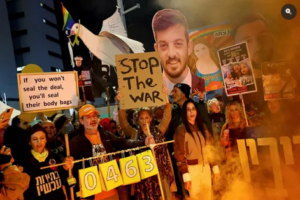Netanyahu just agreed to a hostage deal with Hamas. But it’s not the deal he’s selling his supporters

Pro-hostage deal protesters in Tel Aviv, January 2025
Amir Tibon writes in Haaretz on 15 January 2025:
There are two versions of the cease-fire and hostage release deal that Israel and Hamas have just agreed to. One version is the official document, which is almost identical to leaked drafts from previous rounds of negotiations. The second version is the deal as described by the office of Prime Minister Benjamin Netanyahu and his loyalists in the Israeli and U.S. media.
The gaps between these two versions represent an attempt by Netanyahu to erase a disturbing truth about this deal – that it could have been reached months ago, when some hostages who were killed or murdered over the summer were still alive. But it also tells us something worse: that even after the cease-fire deal comes into effect, Netanyahu could try to sabotage its second phase to renew the war.
The text of the deal draws a clear path to ending the war in return for the release of all hostages. At first, a group of 34 hostages – the majority of them alive – will be released over the course of 42 days, during which Israel will withdraw from most of Gaza, leaving some forces within a defined “perimeter zone” at the eastern edge of the coastal enclave.
Then, the second phase of the deal is supposed to start, during which Israel will receive the remaining living hostages − mostly men under age 50 − in return for a completion of its withdrawal from Gaza. Last but not least, there will be an exchange of dead bodies between Israel and Hamas that will mark the final and official end of the war.
But a different version of the deal appears in statements and briefings published by Netanyahu’s office and his media loyalists. In this version, phase 2 of the deal is a dead letter, and Israel is hell-bent on renewing the war after the completion of phase 1, even at the cost of sacrificing its male hostages.
Don’t take my word for it – trust Netanyahu’s own aides and confidantes − like his chief of staff, Yossi Fuchs, who wrote on Wednesday that the deal “includes the option to resume the fighting at the end of phase 1 if the negotiations over phase 2 don’t develop in a manner that promises the fulfillment of the war’s goals: military and civil annihilation of Hamas and a release of all hostages.”
Read these lines again, and ask yourself: how can phase two of the deal – during which Israel is supposed to completely withdraw from Gaza in return for the release of all remaining hostages – lead to the “military annihilation” of Hamas? Obviously, it can’t, and Netanyahu’s top aide is basically saying that if this is the result, the war will be renewed.
Similar messaging already began appearing on Tuesday afternoon in media outlets supportive of Netanyahu. Amit Segal, Netanyahu’s mouthpiece on Channel 12, wrote a long post explaining that phase 1 of the deal is necessary to provide President-elect Donald Trump with an achievement ahead of his return to the Oval Office, but that Trump doesn’t truly care about ending the war and will not object to Israel walking away from phase 2.
This effort can be seen as simple propaganda – an attempt to convince Netanyahu’s base of right-wing voters in Israel that the deal isn’t as bad as many of them think at the moment. But that’s not the whole story. Fuchs and Segal both know all too well that every word they write and say is also watched closely by Hamas’ leadership in Gaza − which, up until Wednesday afternoon, was still deliberating whether or not to sign the multi-phase deal. Imagine Hamas’ leadership in Gaza reading these statements from Netanyahu’s top aide and the journalist most affiliated with him and asking themselves – are we entering a trap?
These statements carried a dangerous potential to harden Hamas’ position and sabotage the deal. But fortunately, Netanyahu and Segal aren’t playing on the field alone this time. The families of U.S. hostages held in Gaza understood in real time what was happening and used their own channels of influence to make sure the incoming Trump administration doesn’t allow either side – not Netanyahu and not Hamas – to scuttle the shift from phase 1 to phase 2, and with it, the completion of the deal.
Still, the real test for the Trump administration on this issue will arrive in a month, as the deadline for the implementation of phase 2 gets near. Netanyahu and his loyalists have made their intentions clear – they want to scuttle the second part of the deal and avoid a commitment to ending the war. It will be up to the new American president to hold everyone to the text of the deal, guaranteeing the release of all hostages and an end to the war.
This article is reproduced in its entirety
